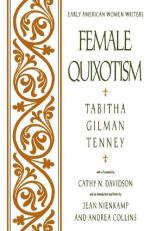|
This section contains 7,209 words (approx. 25 pages at 300 words per page) |

|
SOURCE: Harris, Sharon M. “Lost Boundaries: The Use of the Carnivalesque in Tabitha Tenney's Female Quixotism.” In Speaking the Other Self: American Women Writers, edited by Jeanne Campbell Reesman, pp. 213-28. Athens: The University of Georgia Press, 1997.
In the following essay, Harris argues that Tenney's employment of the carnivalesque in Female Quixotism exposes the limitations of the purportedly democratic government of the United States during the early years of the new nation.
When Tabitha Gilman Tenney's novel Female Quixotism was published in 1801, it joined a national voice of lament over the dangers of novel reading. The typical antinovel argument was that the genre's romantic allurements would lead women away from the realities of their domestic responsibilities. In Female Quixotism, however, Tenney used a comic, anti-romantic stance in relation to novel reading to demonstrate the failed sense of democracy in the new republic. No element of the citizenry escapes...
|
This section contains 7,209 words (approx. 25 pages at 300 words per page) |

|


